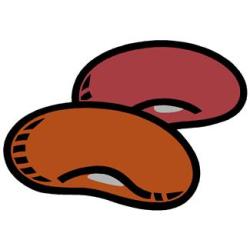Source Institutions
Source Institutions
Add to list Go to activity
Activity link broken? See if it's at the internet archive

In this activity, learners count and measure kidney beans to explore natural selection and variation. Learners measure the length of 50-100 beans. Then they graph and analyze the data including determining the mean, median, mode, and range. Learners identify the type(s) of natural selection occurring in the bean population and answer questions related to biotechnology and commercial farming.
- 10 to 30 minutes
- 1 to 2 hours
- $5 - $10 per group of students
- Ages 14 - 18
- Activity, Experiment/Lab Activity, Lesson/Lesson Plan
- English
Quick Guide
Materials List (per group of students)
- 4 pounds of kidney beans
- 1 - wide mouth container, or 1 - 1000 mL beaker
- 15 or 30 cm metric rulers
- 5 - 50 mL beakers or bathroom Dixie cups
- Lab notebooks
- pens/pencils
- colored pencils
- graph paper
- data charts
Subjects
-
Engineering and Technology
-
Engineering
- Agricultural Engineering
- Bioengineering/Biomedical Engineering
-
Technology
- Agriculture and Biotechnology
-
Engineering
-
Life Sciences
-
Diversity of Life
- Plants
-
Ecology
- Populations
- Evolution
-
Heredity and Genetics
- Patterns of Heredity
- Genetic Engineering
-
Diversity of Life
-
Mathematics
- Algebra
-
Data Analysis and Probability
- Data Analysis
- Data Collection
-
Measurement
- Size and Scale
- Number and Operations
-
The Nature of Science
-
The Scientific Process
- Conducting Investigations
- Gathering Data
- Formulating Explanations
-
The Scientific Process
-
The Nature of Technology
-
Technology and Society
- Technology and the Environment
-
Technology and Society
Informal Categories
- Food and Cooking
- Nature and Environment
Audience
To use this activity, learners need to:
- see
- read
- touch
Learning styles supported:
- Involves teamwork and communication skills
- Involves hands-on or lab activities
Other
This resource is part of:
Access Rights:
- Free access
By:
- Brijbasi, Myrtle
Rights:
- All rights reserved, Access Excellence @ the National Health Museum, 2009
